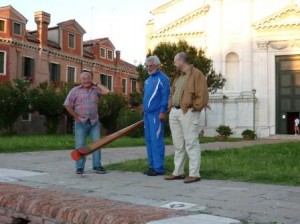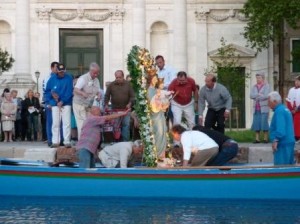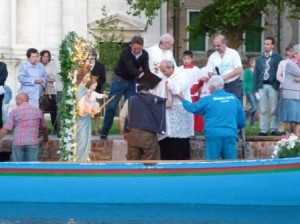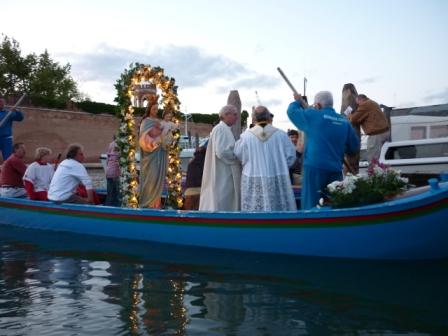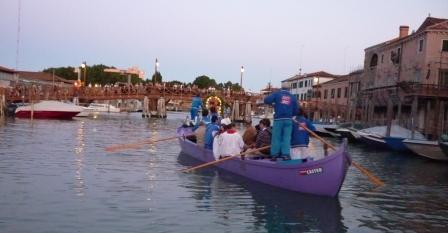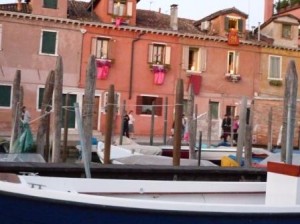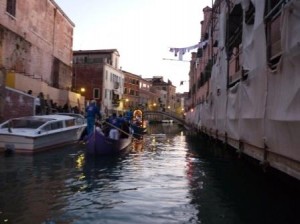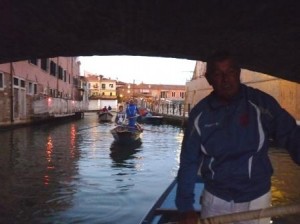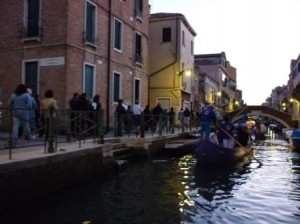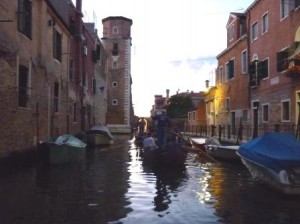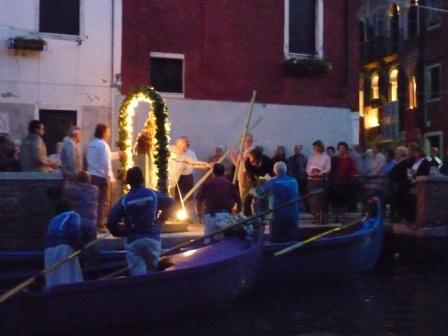Carnival opened officially last Saturday with the parade of the “Marias.” And it opened in a super-mega-jumbo-cast-of-thousandsly way on Sunday with the “Volo dell’ Angelo,” or flight of the angel, in the Piazza San Marco.
On Saturday we personally got our first taste of Carnival by going — do not ask me why, we must have a death wish — to the Rialto market to shop, as we often do on Saturday morning.
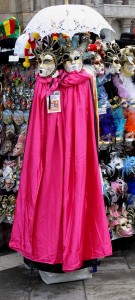
There were so many people in the city at 10:00 AM that they were being left on the vaporetto docks because the vaporettos couldn’t take any more passengers.
Let me pause here, because I don’t want to rant at random. Let me organize the current Carnival scene in as concise a way as I can. And I do this, not because I want to dash glacial water onto anybody’s fantasies of a festival which some widely distributed photographs lead you to believe is made only of dreams and glamor and a batch of feathers. No, I don’t want to do that.
But neither is it Rio or Trinidad or the Fasnacht in Basel or the Carnival in Patras or even, God help us, Mardi Gras in New Orleans. It is a strangely soulless, almost totally manufactured event which every year baffles me more than the year before, the only occurrence here which distresses Venetians more than the cost of living and the lack of affordable housing put together. I’ve lived in other cities which swarm with tourists every day (New York, Washington). The difference is that those are cities. Here, it’s like 70,000 people (official Saturday count) are trying to get into your living room.

So every year I wonder why people come and what they remember when they leave — I mean, apart from the spectacular cost of everything. (A bag of confetti, 2.50 euros, or $3.50, in the Piazza San Marco, is one small example. I ask myself, why acquire pieces of colored paper just to throw them away? You’ll already be doing that with fistfuls of other colored pieces of paper issued by the European Central Bank, beginning the minute you need to pay for anything at all, from a drink to a bathroom, not to mention dinner or a bed.)

Here is what has happened so far:
Parade of the Marias — check. Lovely girls borne aloft on wooden platforms hoisted by gondoliers, and a costumed entourage, wend from San Pietro di Castello to the Piazza San Marco. Great for pictures. So far, so good.
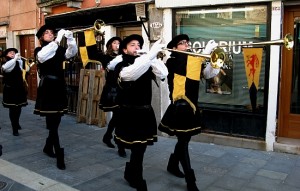
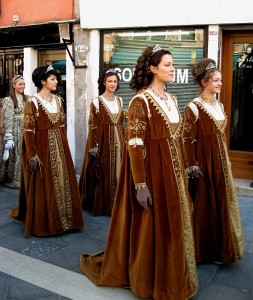
The “Flight of the Angel” — check. Under the Venetian Republic, the intrepid soul who undertook this Flying-Wallendas sort of stunt literally risked (and occasionally lost) his life. This is just a person in a costume sliding down a cable to which she has been cinched at least eight different ways. But there were 80,000 people crammed into the Piazza to watch. Great for pictures.
A “white strike.” I’m not referring to some exotic piece of performance art. It means a major slowdown — not a total strike — by the ACTV, our eccentric public transport company. In its wisdom, the first real weekend of Carnival was clearly the ideal time — two days in which the city’s population doubles — in which to make its labor grievances known, whatever they may be.
On a normal day, the ACTV skips an average of 150 runs anyway. (I’ll wait while that sinks in.) Saturday was worse, because not only did they skip runs at random, thereby creating large accumulations of people at each stop, but the vaporettos went v-e-r-r-r-r-r-y s-l-o-o-o-o-o-o-w-l-y between stops. Seeing as the workers refused to effect extra runs for the entire duration of Carnival, the city was ultimately compelled to hire a private company to provide extra service during peak hours.
Ugo Bergamo, the Assessore (councilor) for Transport, gave a brief interview to explain the situation. To the reporter’s question, “Couldn’t this have been anticipated and prevented?” Mr. Bergamo gave the astonishing reply, “A strike is supposed to create problems, otherwise what kind of a strike is it?” Mr. Bergamo didn’t feel it was appropriate to criticize the ACTV (though plenty of criticism has been made over the past year, not only for erratic service but for ticket sellers stealing money, and the deeply rooted practice of hiring relatives of employees). To him, the ACTV was far more sinned-against than sinning.
He blamed lack of money for problems which were seen as having been imposed on, not created by, the ACTV. (Translation: “Get over it.”) Rather than bring up the strike in the next City Council meeting, he wants us all to take to the barricades to protest the national and regional funding cuts which are flensing the finances of the rogue whale which is the ACTV. Not so great for pictures.
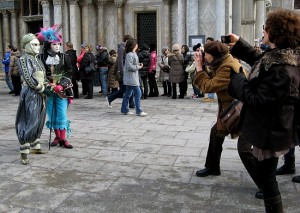
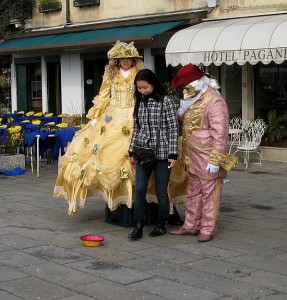
Civil unrest. It was inevitable. In the tiny hours of Sunday night/Monday morning, police and Carabinieri were called to Piazzale Roma to deal with a nascent riot. Hundreds of tired, cold, inebriated revelers had accumulated there expecting to find buses which could take them to the mainland. Well yes, there were a few — so few that the masses essentially assaulted them, while the taxi drivers had to deal with many infuriated people who considered the fares to be a ripoff. (Considering how exorbitant the fares are on a normal day, there’s no telling what the drivers were asking on a Carnival night.) After an hour or two of hard labor, calm was restored, mainly by more buses being brought into service.
“Venice on some occasions demonstrates an alarming lack of direction and coordination,” editor and reporter Davide Scalzotto remarked in an opinion piece the next day. “If this is a city that wants to be considered [as a candidate for] European Capital of Culture, they’d better think it over. That in 2011 one of the world capitals of tourism can’t manage to connect the city on the water with the mainland 24 hours a day is verging on the incredible. First they invite tends of thousands of people to a party and bring lots of money to the ‘touristic categories,’ then they abandon them in the middle of the street to work it out for themselves.”
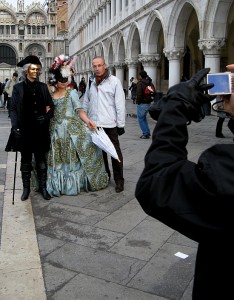
No special trains. This was a departure from past years and obviously creates more logistical misery for the revelers. Negotiations between the city and Trenitalia sputtered and died because nobody could reach an agreement on who would pay the bill for the extra service. Of course we already know that no ghe xe schei. Certainly not here, and evidently not at Trenitalia, either. Perhaps it’s under the potted palm.
The Grand Foyer: Now this was something new. When the partyers finally got to the Piazza San Marco, they discovered that 3/4 of the area had been closed off to form a sort of VIP area called the “Grand Foyer.” Depending on the day, the cost of a ticket to enter this realm ranged from 5 to 100 euros, and was offered as a very special way to enjoy proximity to the stage for the show(s) and some other perks. (Like seats on risers to watch the concert, or bags of confetti for 2.50). The organizers made no secret of their idea that this was intended as another way to make some of that missing schei, but so few people availed themselves of this opportunity– considering that they could see the show just as well from outside the fence — that eventually they let people in for free. (Does this remind you of anything? Peace and love, man.)
It’s true that you could dress up in an expensive rented costume (at least 200 euros) and attend a really glamorous party, like the one given at the Palazzo Pisani-Moretta on the Grand Canal. Tickets to that cost a mere 700 euros.
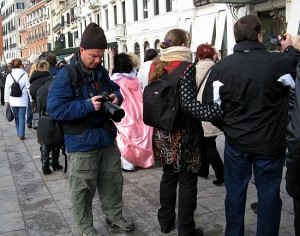
Or you could buy a mask and walk around taking pictures of people in masks and costumes. Or you could skip buying a mask and just walk around taking pictures. This seems to be what most people prefer.
We ran into a friend as we walked home Monday morning, and we indulged in a few choruses of a song which by now one knows all too well, the title of which could be “This isn’t Carnival, this is madness.” “People will do anything just to make money.” “Carnival is dead. Every year they just put more lipstick on the corpse.”
Naturally the city and its various Carnival-not-organizing components have already begun the spin. Speaking of how the Grand Foyer was working out, Piero Rosa Salva, the head of Venezia Eventi e Marketing, tranquilly described it as a sort of creative work-in-progress, an experiment. You can’t call an experiment a mistake, because, well, you’re experimenting. I myself can’t find a way to take seriously a project which could be labeled, “Let’s charge people lots of money for something they can get for free.” (Actually, I haven’t even tried to take it seriously.) But they’re still trying to understand why it didn’t work — so they can make it work better next time. Meanwhile, the private partners (Expo Venice and Attiva), which signed a three-year agreement with the city to share the cost of the stage, among other things, are probably already wondering what they were thinking.
Me, I’m always wondering what they were thinking.
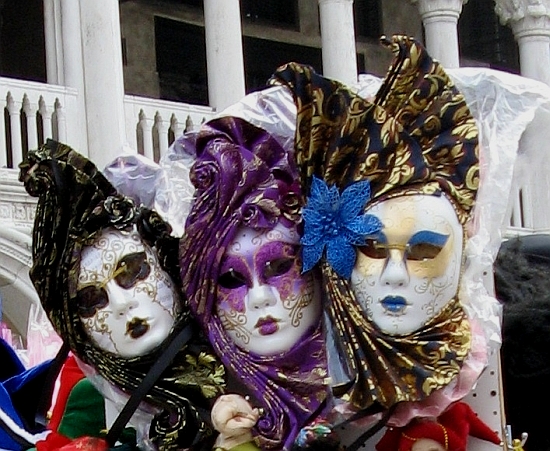

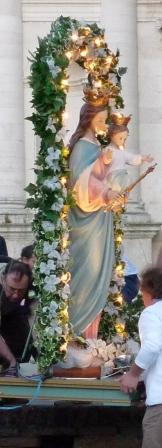 Our neighborhood is one of the few which is still inhabited by enough people who care to maintain certain religious habits which used to be pretty common in most parishes in Venice, but now are virtually extinct.
Our neighborhood is one of the few which is still inhabited by enough people who care to maintain certain religious habits which used to be pretty common in most parishes in Venice, but now are virtually extinct. 